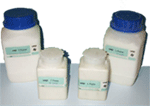What are UOP L and T?UOP L and T powders and pastes are highly effective
moisture scavengers for many plastics and coatings
systems. These powders and pastes are molecular sieve
zeolites; they have a crystal structure of the zeolite A
type and the following chemical composition:
M12(AlO2)12(SiO2)12
(M = alkali cation)
The zeolite structure consists of SiO4 and
AlO4
tetrahedrons, which are linked to one another to form a
three-dimensional network. The structure of this network
is such that, inside the crystal lattice, large
adsorption cavities are formed, which are connected to
one another by channels of defined and absolutely
identical diameter.
This diameter depends on the type of cation and is approximately 4 Ůgstrom units in the case
of UOP T Powder and Paste and approximately 3 Ůgstrom
units with UOP L Powder and Paste (1 Ůgstrom = 10-8
cm). The only molecules that can be adsorbed are those
smaller than the diameter of the pores. This means water
can be adsorbed, but the raw materials for plastics,
coatings systems and adhesives cannot.

Samples Samples of L Powder, L Paste, T
Powder, and T Paste are available upon request. Samples
come in one pound quantity.
Call 724-942-3090 for more information and pricing.

Call Today!
Phone: (724) 942-3090
Fax: (724) 942-3091 |
 |
UOP Powder or UOP Paste?Either form can be used in the same systems. The paste
form has the following advantages over the powder form:
- Easier to incorporate into any system
In the paste form, the solid has already been
homogeneously dispersed. This means that no further
dispersing energy is required during formulation; the
paste can be dispersed quickly and absolutely
homogeneously into the polyol component by simply
stirring it in. This saves energy and machine hours!
- Easier to handle
A moisture scavenger naturally also adsorbs moisture
from the air. UOP paste is prepared by adding the powder
to hydrophobic castor oil. This prevents atmospheric
moisture from entering the zeolite, which means that the
paste adsorbs virtually no moisture at all during
handling or if allowed to stand in the open air. Even if
drums have been opened and are left by mistake overnight
or for the weekend without a cover, the paste can still
be used.
It has been taken into account when using the paste form
that the castor oil itself acts as a polyol and, because
of its OH groups, is incorporated into the polyurethane
structure (OH content of castor oil: approximately 5%).
UOP T or UOP L?
UOP T Powder and Paste have been successfully used in a
wide variety of systems. UOP L Powder and Paste have the
following additional advantages:
- Higher surface quality of coatings
Whereas UOP T, because of its structure, may still
contain small amounts of adsorbed gas (N2, CO2), UOP L
is gas free. This means that coatings and casting resins
can cure without any defects.
- Stable pot life
The use of UOP T can, in certain two-pack systems and
especially in the presence of short-chain polyether
polyols, produce a shortening of the pot life. When UOP
L is present, however, a pot life, once it has been set,
remains completely stable even if it is stored for a
long time before application. In the case of one-pack
sealants, the use of UOP L leads to an improvement in
the storage stability.
The UOP Powder and Paste is always added together with
the fillers and pigments to A component (polyol
component) of the system. UOP Powder and Paste adsorb
water very quickly. Generally speaking the polyol
component needs to stand for only one hour minimum, but
preferably overnight, before curing can be carried out
by adding the isocyanate component. |